This Thai choo chee curry recipe is an easy red curry dish perfect for a busy weeknight. I’ve opted for shrimp, but you can prepare this recipe with any type of seafood, fish, or your favorite meat. It’s ready in less than 30 minutes with no more than 7 traditional Thai ingredients!
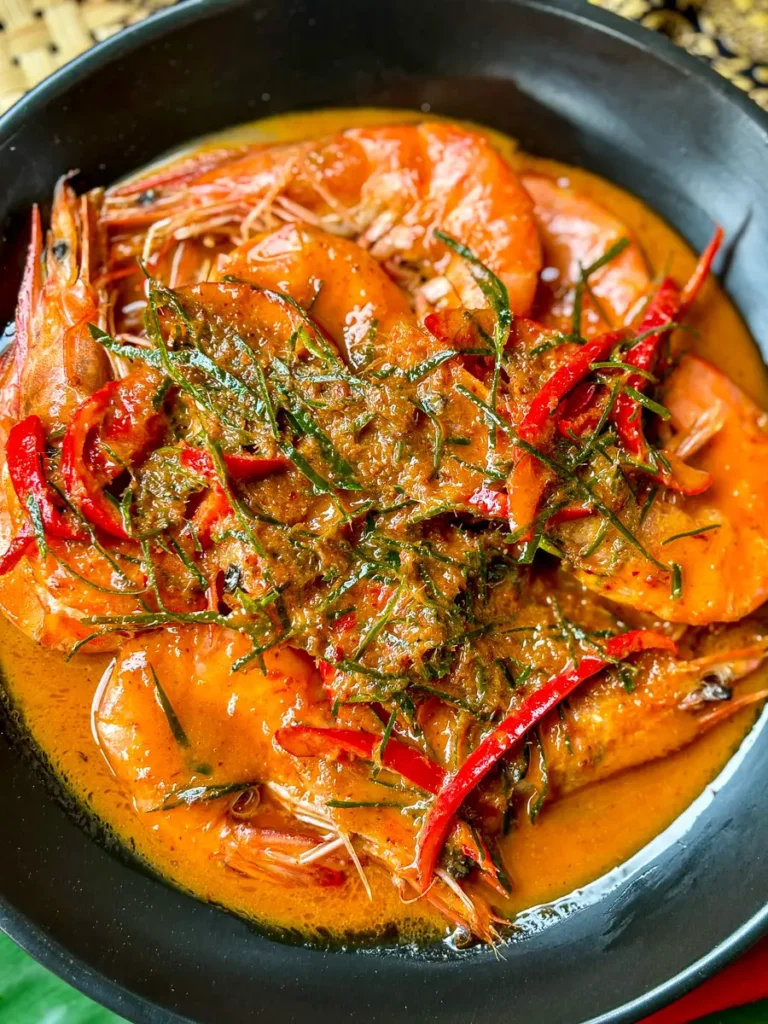
What you’ll love about choo chee shrimp is its simplicity and the delicious creamy red coconut curry sauce.
I used my homemade Thai red curry paste, which adds to the authenticity and flavor. You can also use this Thai curry paste in my recipes for Thai red curry fish, authentic Thai red curry recipe, and gaeng daeng.
What is choo chee curry
Choo chee curry is a type of Thai red curry with a creamy coconut sauce. In Thailand, it’s often prepared with fish or seafood, like shrimp. The key ingredient in this curry is kaffir lime leaves, which add a sort of citrus taste and aroma.
Choo chee goong
This Thai shrimp curry (choo chee koong) is one of my favorites because it’s so quick and easy to make with just a few ingredients. Although not many ingredients are used, it’s still an incredibly flavorful and fragrant Thai red curry with a creamy coconut sauce.
I love serving this spicy Thai dish with a portion of steamed jasmine rice, so I can dip it in the delicious choo chee sauce. This creamy and spicy sauce can easily be adjusted to taste before serving. When cooking Thai food, it’s important to find a good balance between spicy, sweet, and salty.
If you like it spicy, you can add fresh chili peppers like bird’s eye chilies or Thai jinda chilies. I chose to use only a prik chi fa, which is a large Thai chili with a mild spiciness but lots of flavor.
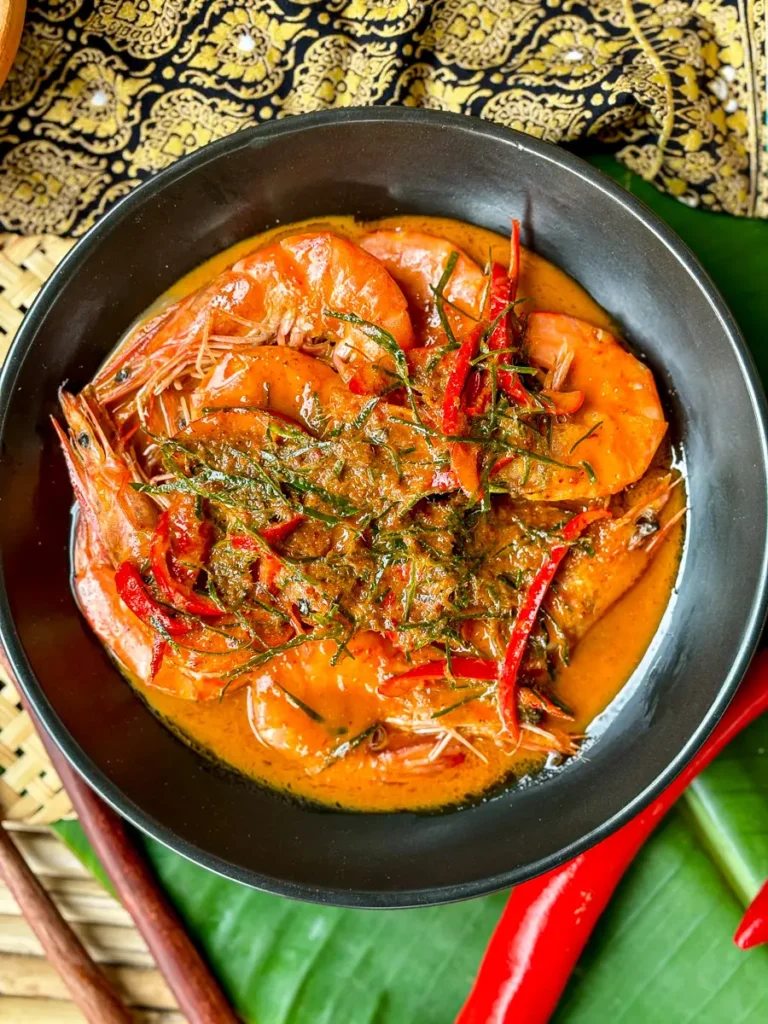
The unique aspect of this curry is that the protein is cooked in a separate pan from the curry sauce. This method makes it easy to change the protein type because you just pour the sauce over the cooked protein before serving!
As mentioned earlier, this Thai curry is often made with fish (choo chee pla). This can be any type of fish, such as salmon, tilapia, or even white fish fillets. Personally, I prefer it with shrimp, but it can also be made with other seafood like squid or even meat such as chicken, pork, or beef.
Just like with beef panang curry, there are no or very few vegetables in choo chee. If you’re vegetarian or vegan, you can opt for tofu and add vegetables like bell peppers and Thai eggplants. Don’t forget to choose a vegan fish sauce alternative. You’ll also need to find a vegetarian red curry paste, since many store-bought versions contain shrimp paste!
It’s a very diverse curry that you can take many different directions with. You can turn it into the perfect Thai meal for every day of the week, and even serve it at family gatherings with less spice for the kids.
Ingredients
Ingredients can be sourced at Asian grocery stores and Asian markets.
The exact measurements are in the recipe card at the end of this post.
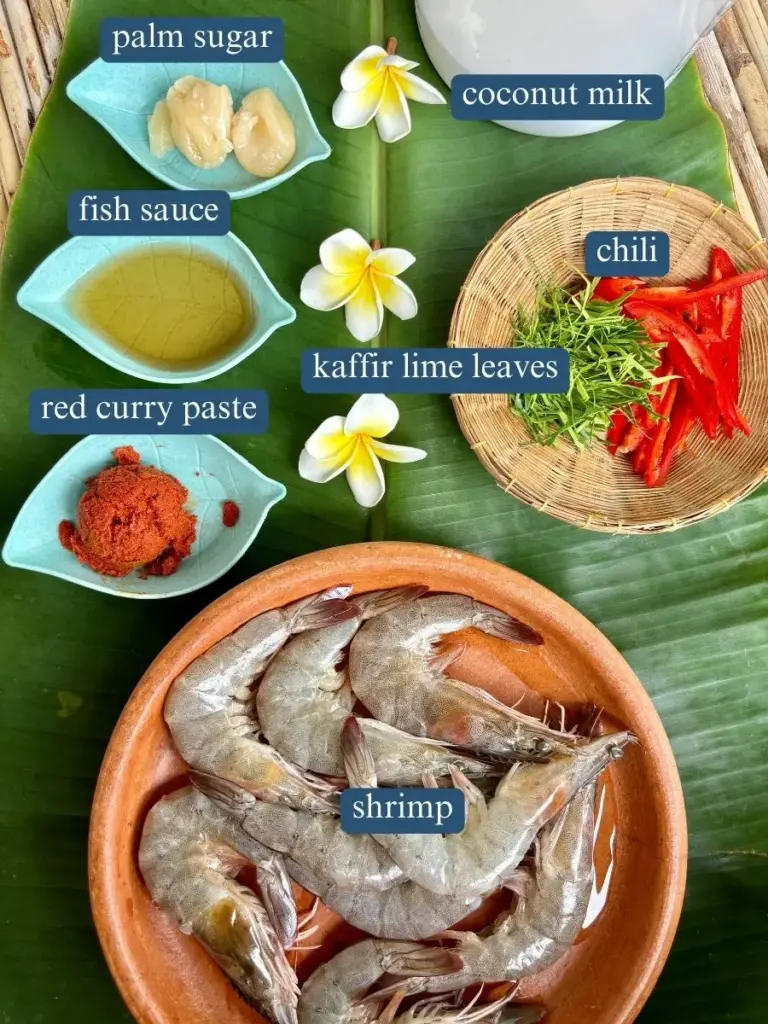
- Shrimp – I recommend choosing large shrimp varieties such as tiger shrimp, jumbo shrimp, or even tiger prawns. You can choose to peel them in advance or not. Make sure to clean and devein them.
- Red curry paste – For the best flavor, use my homemade Thai red curry paste. If you’re short on time, you can get a store-bought paste like Mae Ploy or Maesri at Amazon.
- Fish sauce – Fish sauce is one of the key ingredients for a salty and umami flavor. My go-to brand is Megachef.
- Palm sugar – When making this Thai seafood curry, I prefer palm sugar over white and brown sugar for the caramel-like flavor it adds.
- Coconut milk – Opt for full-fat coconut milk for a rich and creamy choo chee curry sauce.
- Prik chi fa – If you can’t find this type of Thai chili pepper, you can simply use serrano peppers or others as an alternative.
- Kaffir lime leaves – If you can’t find fresh makrut leaves, try looking for dried kaffir lime leaves at Asian supermarkets.
- Oil – Use a neutral oil with high smoke point, like canola oil or vegetable oil.
Cooking instructions
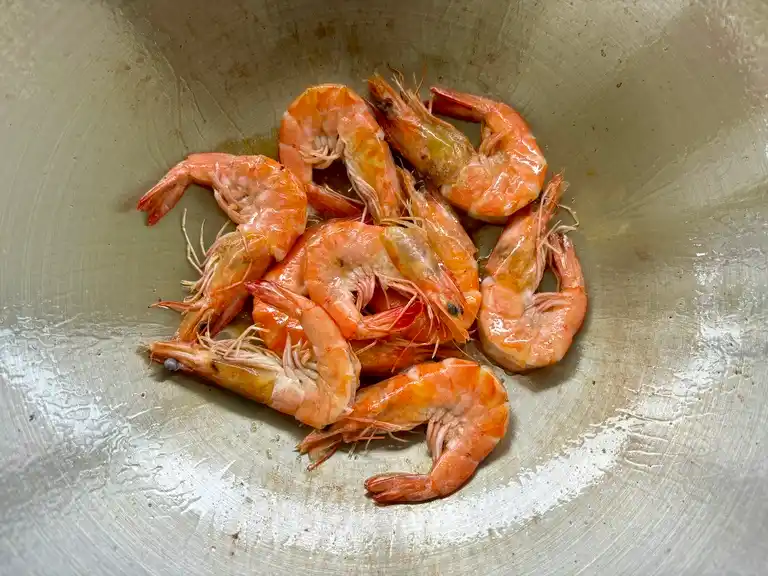
Step 1: Heat oil in a wok or a non-stick skillet over medium heat. Sauté the shrimp until they’re cooked and red on both sides. Remove the shrimp from the pan and transfer them to a serving dish.
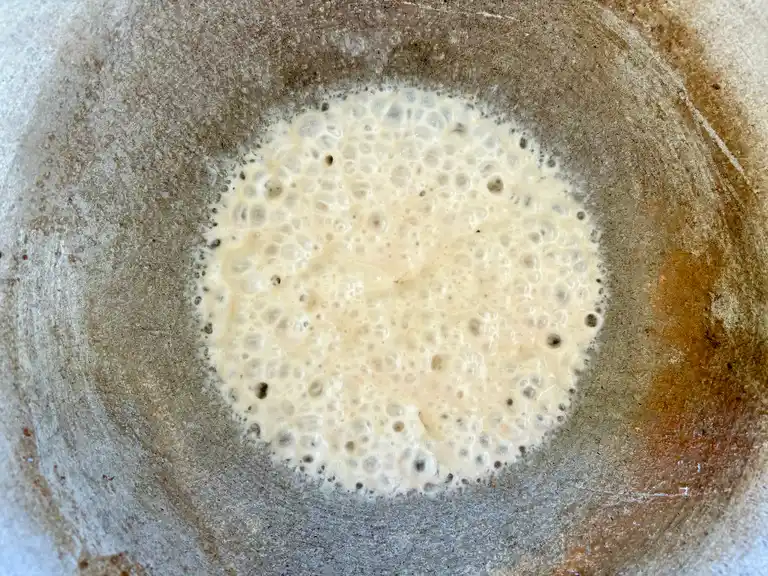
Step 2: Into the same wok, pour 100ml (about 3.40 fl oz) of coconut milk and set it over medium heat. Allow it to boil gently while stirring, reducing the milk until you see the coconut oil beginning to separate.
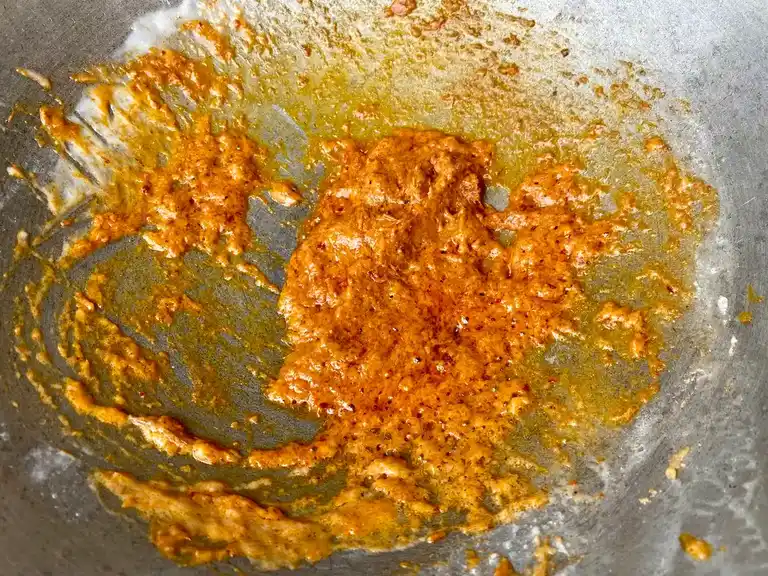
Step 3: Stir in the curry paste with the reduced coconut milk. Mix well until the paste is thoroughly combined with the milk.
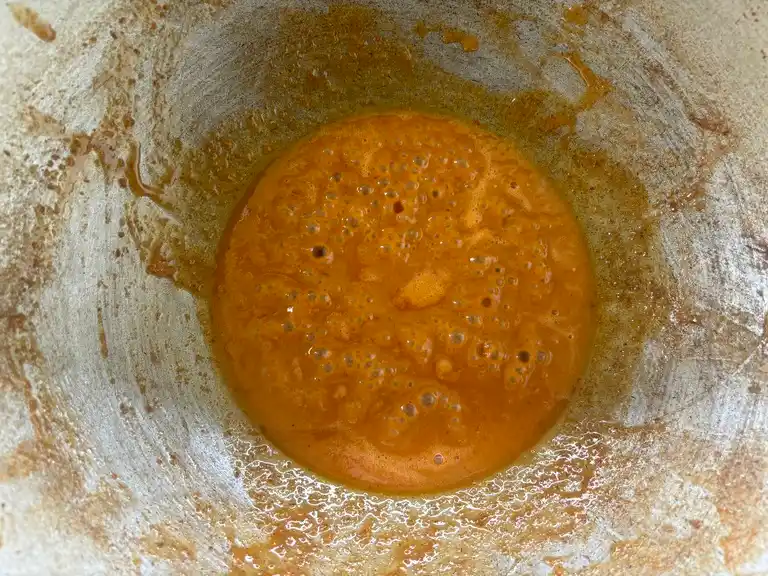
Step 4: Follow up with the remaining coconut milk. Bring the mixture to a simmer, then blend in the palm sugar and fish sauce, stirring until the sugar dissolves completely.
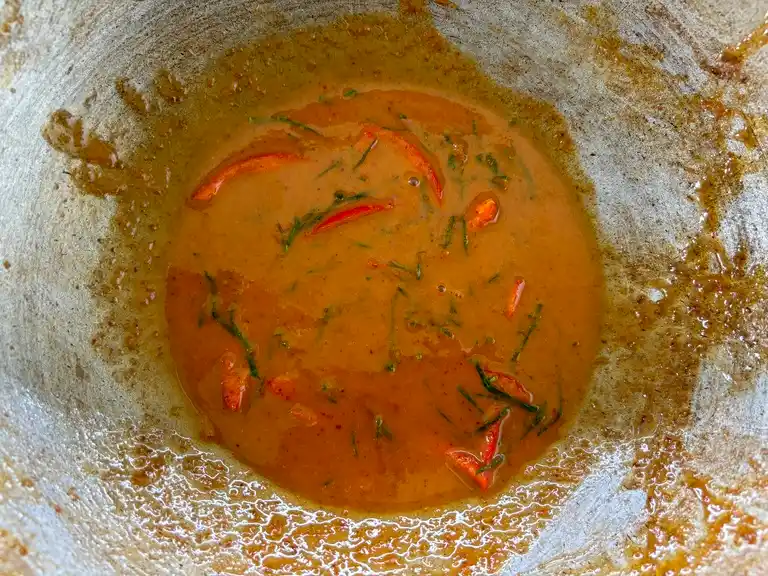
Step 5: Add kaffir lime leaves strips and sliced chilies, give it a good stir, and turn off the heat.
Step 6: Pour the choo chee curry sauce over the cooked shrimp in a serving dish. Serve alongside steaming jasmine rice and enjoy!
Kitchenware
Here’s what you’ll need to get started:
- Knife and cutting board
- Measuring cups and spoons
- Mortar and pestle or food processor (for homemade red curry paste)
- Large wok or non-stick skillet
- Spatula or stirring spoon
Choo chee recipe tips
Taste-testing before serving is a golden rule in Thai cooking. Try creating a perfect balance between salty, spicy, and sweet by tweaking this recipe and adjusting the balance of tastes to what you love most.
Adjust the spiciness by deseeding the chilies if needed. Alternatively, you can add spicy chilies like bird’s eye chilies for extra heat.
Slice the kaffir lime leaves into thin strips by stacking a few leaves on top of each other and rolling them up. Then, you can chop them into very fine pieces! This will save you some time during prep work.
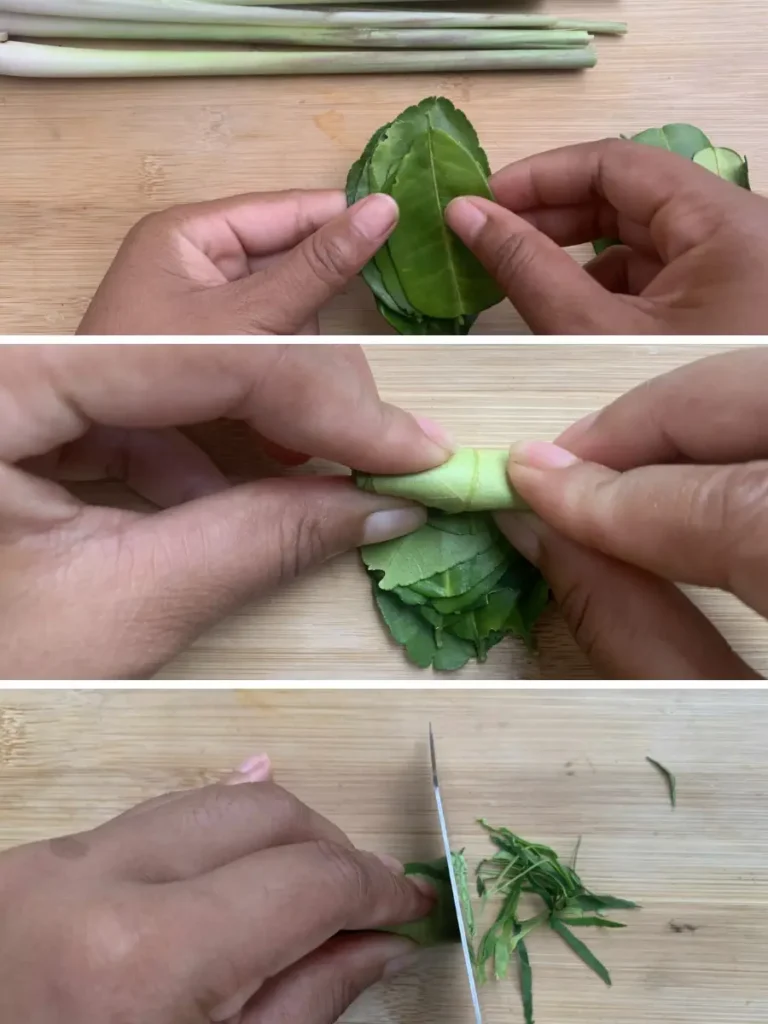
What to serve with chu chee curry
Most of my Thai curry recipes are best served with a side of steamed jasmine rice. The steamed rice soaks up the choo chee sauce and it also helps temper the heat. If desired, you can add a side of Thai vegetables stir-fry or a spicy salad like som tum Thai.
How to store leftover curry
Storing: Let your leftover curry cool to room temperature and transfer it into an airtight container. You can keep it like this in the fridge for up to 2 days.
Reheating: Reheat the leftover curry in a pot over medium heat. Stir it now and then until it’s warm and ready to eat.
Frequently asked questions
What does choo chee curry taste like?
Choo chee curry is a rich and creamy curry with a balanced mix of salty, sweet, and spicy flavors. It’s got a fresh flavor from kaffir lime leaves and is often prepared with fish or seafood.
Is choo chee sauce spicy?
Yes, choo chee sauce is a bit spicy because of the red curry paste. Sometimes, extra chilies can be added, which makes the sauce even spicier. The spice can be adjusted to your liking.
Can I make this in advance?
Yes, you can make this curry in advance. Just keep it in the fridge and reheat when you’re ready to eat.
Is this recipe gluten-free?
Yes. But make sure to double-check the labeling of your store-bought ingredients like curry paste.
Authentic Thai curry recipes
- Vegetarian Thai green curry
- Gaeng massaman neua
- Kabocha squash curry
- Vegan yellow curry
- Gaeng panang gai
- Swimming rama
Loved reading this Thai choo chee curry recipe? Please make my day by dropping a star rating and/or a comment below! Follow me on social media: Facebook, Instagram, and Pinterest.
Thai Choo Chee Curry Recipe

Ingredients
- 12 medium shrimp, deveined, see notes
- 15 g red curry paste, see notes
- 15 ml fish sauce
- 12 g palm sugar
- 300 ml coconut milk
- 1/2 large chili, see notes
- 2 kaffir lime leaves, sliced into thin strips
- 15 ml oil
Instructions
- Heat oil in a wok or a non-stick skillet over medium heat. Sauté the shrimp until they’re cooked and red on both sides. Remove the shrimp from the pan and transfer them to a serving dish.
- Into the same wok, pour 100ml (about 3.40 fl oz) of coconut milk and set it over medium heat. Allow it to boil gently while stirring, reducing the milk until you see the coconut oil beginning to separate.
- Stir in the curry paste with the reduced coconut milk. Mix well until the paste is thoroughly combined with the milk.
- Follow up with the remaining coconut milk. Bring the mixture to a simmer, then blend in the palm sugar and fish sauce, stirring until the sugar dissolves completely.
- Add kaffir lime leaves strips and sliced chilies, give it a good stir, and turn off the heat.
- Pour the choo chee curry sauce over the cooked shrimp in a serving dish. Serve alongside steaming jasmine rice and enjoy!
Notes
- Use the nutrition card in this recipe as a guideline.
- Shrimp – I recommend choosing large shrimp varieties such as tiger shrimp, jumbo shrimp, or even tiger prawns. You can choose to peel them in advance or not. Make sure to clean and devein them.
- Red curry paste – For the best flavor, use my homemade red curry paste, which you can freeze for later use. If you’re short on time, you can get a store-bought paste like Mae Ploy or Maesri at Amazon.
- Large chili – I used a Thai prik chi fa chili. If you can’t find this type of Thai chili pepper, you can simply use serrano peppers or others as an alternative.




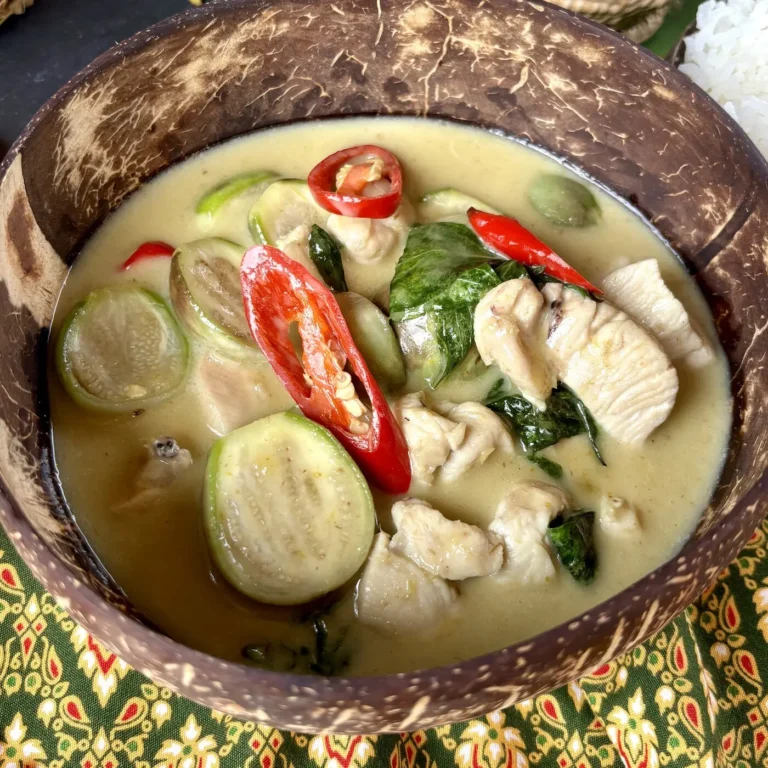


Simple and easy to do. I wasn’t able to find Kaffir Lime leaves near me in London, UK, so I used fresh lime juice as a replacement. I found 13g of palm sugar too sweet, so the next time I used half of that amount and the recipie was spot on for my taste.
Thank you Praew!
Thank you Samantha! Great to hear that you are actively working on adjusting the flavors to your taste!
Very tasty! Love the taste of palm sugar, it really gives something more to the recipe.
Thanks, Alice!